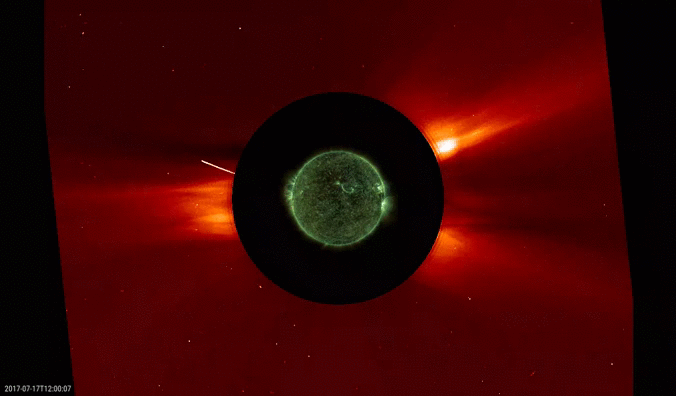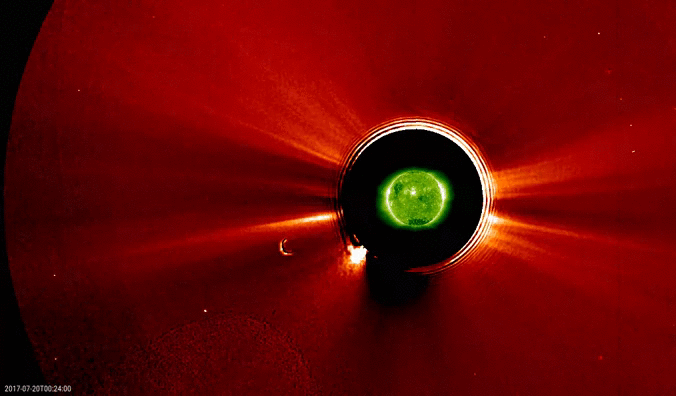Early on 18 July, NOAA 2665 rounded the west limb. It had already produced a strong eruption on 14 July (see this news item), but continued its activity with complex eruptions late on 17 July and a spectacular one on 20 July (see the supplementary movie clips at the end of this article). Nonetheless, the cherry on the pie was the 23 July farside eruption, which reminded many of the Carrington-like event that took place exactly 5 years ago, also on the Sun’s farside (see this news item for more info on this eruption).

At the time of the 23 July event (STEREO-A imagery above), NOAA 2665 was located about 61 degrees behind the west limb as seen from Earth, so the eruption did not trigger a GOES x-ray flare. The sketch underneath to the left shows the positions of Earth (green), STEREO-A (red) and Mars (grey) with respect to the Sun (yellow) as seen from above. To the right, and also seen from above the Sun, half arcs indicate which part of the Sun can be seen from these 3 vantage points (same color code). The blue dots indicate the position of NOAA 2665 at each of its eruptions on 14, 17, 20 and 23 July. While completely invisible from Earth, the 23 July event took place at the east limb as seen from STEREO-A, and well on the eastern solar hemisphere as seen from Mars.
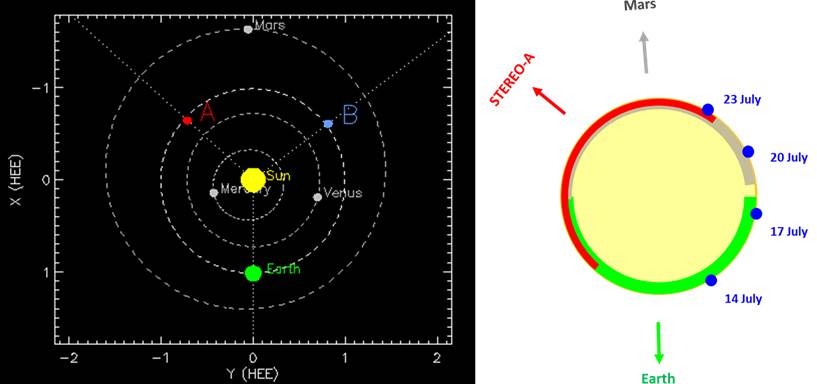
The 2012 eruption originated in NOAA 1520, one of the largest sunspot regions of solar cycle 24 (SC24). As can be seen in the table underneath, it reached a maximum sunspot area twice that of NOAA 2665, or the equivalent of about 8 times the Earth's surface (see this news item for more info on sunspot areas). At the time of the eruption, it was not as far over the west limb as NOAA 2665 in 2017 (43 degrees vs. 61 degrees). However, for STEREO-A, which has been rounding the Sun's farside over the last few years, it made a big deal. Indeed, the 2012 eruption was located close to the central meridian (12 degrees west), whereas during the 2017 event, the active region had barely rounded the east limb (78 degrees east).
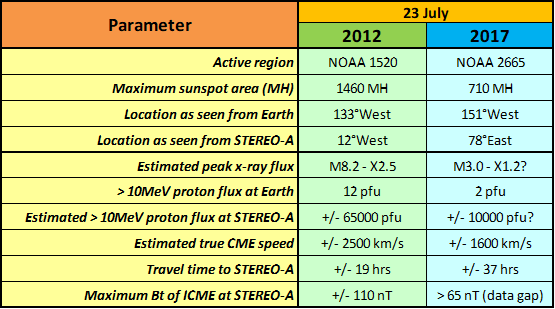
Due to their position on the Sun's farside, both 23 July flares could not be recorded by the GOES spacecraft. However, some ingenious use of STEREO-A's EUV (extreme ultraviolet) imagery and data allows to deduce a likely range for the peak of the x-ray flare (Nitta et al. 2013 ; Chertok et al. 2015). For the 2012 blast, this peak would most likely have been between M8.2 and X2.5. The 2017 flare seems to have been somewhat less intense, between M3.0 and X1.2. Hence, a low-level X-class event cannot be excluded. Testifying for the strength of this eruption were the strong coronal dimming, the obvious coronal wave, and the series of bright post-flare coronal loops ("arcade"). See STEREO-A's EUV imagery underneath (EUVI 195).
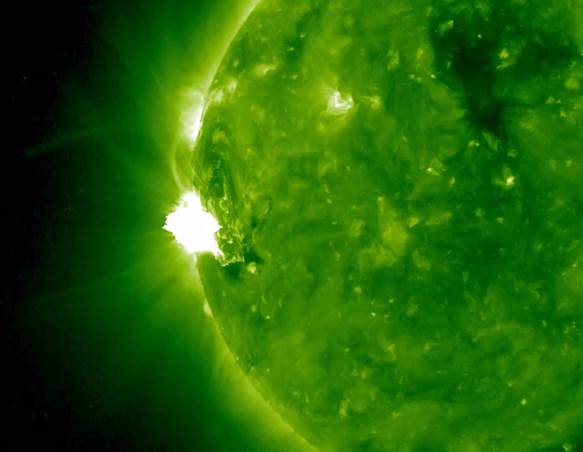

STEREO-A also observed a strong increase in the number of protons with energies greater than 10 MeV (see news item for more details on the intensity and units for proton events), despite being on the "wrong" side of the eruption and thus not well connected to the source region. This is in contrast to the 2012 event, where conditions were almost ideal for a strong proton event. It was calculated that GOES would have measured a severe energetic storm particle (ESP) event of about 65.000 pfu in 2012 (Gopalswamy et al. 2014 ; Gopalswamy et al. 2016). Looking at the relevant particle graph (red curve underneath) as recorded by STEREO-A, it becomes clear that the 2017 ESP event was not as intense, and a crudely estimated peak value of about 10.000 pfu seems even optimistic. The much weaker 2017 proton event is emphasized by the fact that STEREO-A's EUV imagery was barely affected by the proton impacts (see image comparison underneath, at the time of the peak). Also, the proton flux observed at Earth was only enhanced to 2 pfu, whereas in 2012 it reached 12 pfu and thus became a genuine proton event (>10 pfu), despite the source region being so far beyond the west limb!
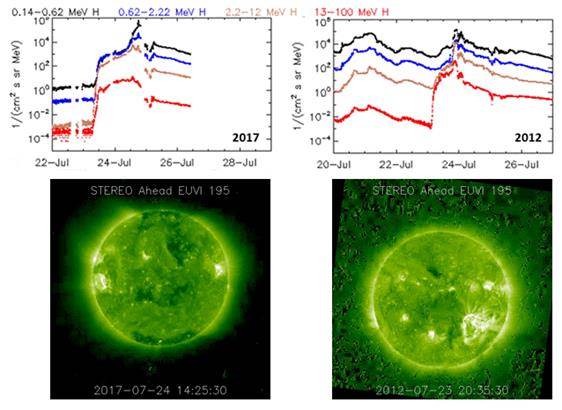
The coronal mass ejection (CME) associated with this eruption was a halo CME as observed from STEREO-A, Mars and Earth. Obviously, the CME was directed away from Earth. The speed of the CME was calculated to be around 1600 km/s, and it arrived at STEREO-A about 37 hours later. These are no extraordinary figures, in contrast to the 2012 CME which reached an estimated speed of 2500 km/s (Baker 2016), making this a "rare" event on the SCORE-scale (Evans et al. 2013). The plasma cloud passed the STEREO-A spacecraft only 19 hours later making this a very rare Fast Transit Event (FTE), truly comparable to the Carrington event in 1859. The intensity of the magnetic field (Bt) of the interplanetary CME reached 110 nT in the 2012 event, and was at least 65 nT in 2017, but a data gap prevents a more accurate assessment. Mars is expected to be closer to the bulk of the CME, with a most likely impact predicted for 26-27 July.

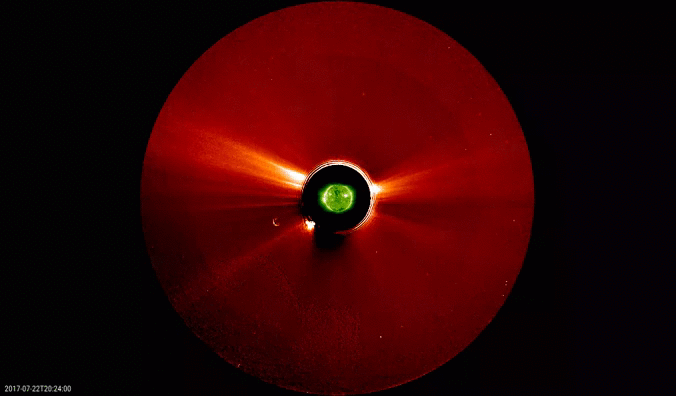
The above findings indicate that the 23 July 2017 event was a strong one so deep in SC24, but at the same time they also suggest that it was a lot more modest than the 2012 eruption on all three counts: flare strength, proton flux and the CME speed and intensity. There's no doubt that the NOAA 2665's complex and spectacular eruptions from 14, 17, 20 and 23 July will be extensively researched in years to come.
Supplementary movie clips on the C1 Long Duration Events on 17 and 20 July

